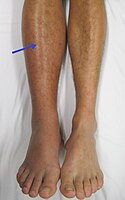
Photo from wikipedia
Assuring availability of services for patients with lymphedema is required for countries to be validated as having achieved elimination of lymphatic filariasis (LF). A direct inspection protocol (DIP) tool, designed… Click to show full abstract
Assuring availability of services for patients with lymphedema is required for countries to be validated as having achieved elimination of lymphatic filariasis (LF). A direct inspection protocol (DIP) tool, designed to measure the readiness to provide quality lymphedema management services, has recently been developed. The DIP tool includes 14 indicators across six quality themes: trained staff, case management and education materials, water infrastructure, medicines and commodities, patient tracking system, and staff knowledge. We evaluated the use of the tool in Vietnam, where data were needed to inform validation efforts. To apply the tool in Vietnam, we compiled a list of 219 commune health stations (CHS) with known lymphedema patients and conducted a cross-sectional survey in 32 CHS; including 24 in Red River Delta region, 2 in the North Central region, and 6 in the South Central Coast region. The mean facility score, calculated by assigning 1 point per indicator, was 8.8 of 14 points (63%, range 4[29%]-13[93%]). Percentage of surveyed facilities with staff trained in last two years was 0%; availability of lymphedema management guidelines (56%); availability of information, education, and communication materials (16%); reliable improved water infrastructure (94%); availability of antiseptics (81%), antifungals (44%), analgesics or anti-inflammatories (97%), antibiotics (94%); supplies for lymphedema and acute attack management (100%); lymphedema patients recorded in last 12 months (9%); staff knowledge about lymphedema signs/symptoms (63%), lymphedema management strategies (72%), signs/symptoms of acute attacks (81%), and acute attack management strategies (75%). The tool allowed standardized assessment of readiness to provide quality services. Lack of trained health staff, limited patient tracking, and depletion of education materials were identified as challenges and addressed by the national program. Survey data were included in the validation dossier, providing evidence necessary for WHO to validate Vietnam as having eliminated lymphatic filariasis in 2018.
Journal Title: PLoS Neglected Tropical Diseases
Year Published: 2020
Link to full text (if available)
Share on Social Media: Sign Up to like & get
recommendations!